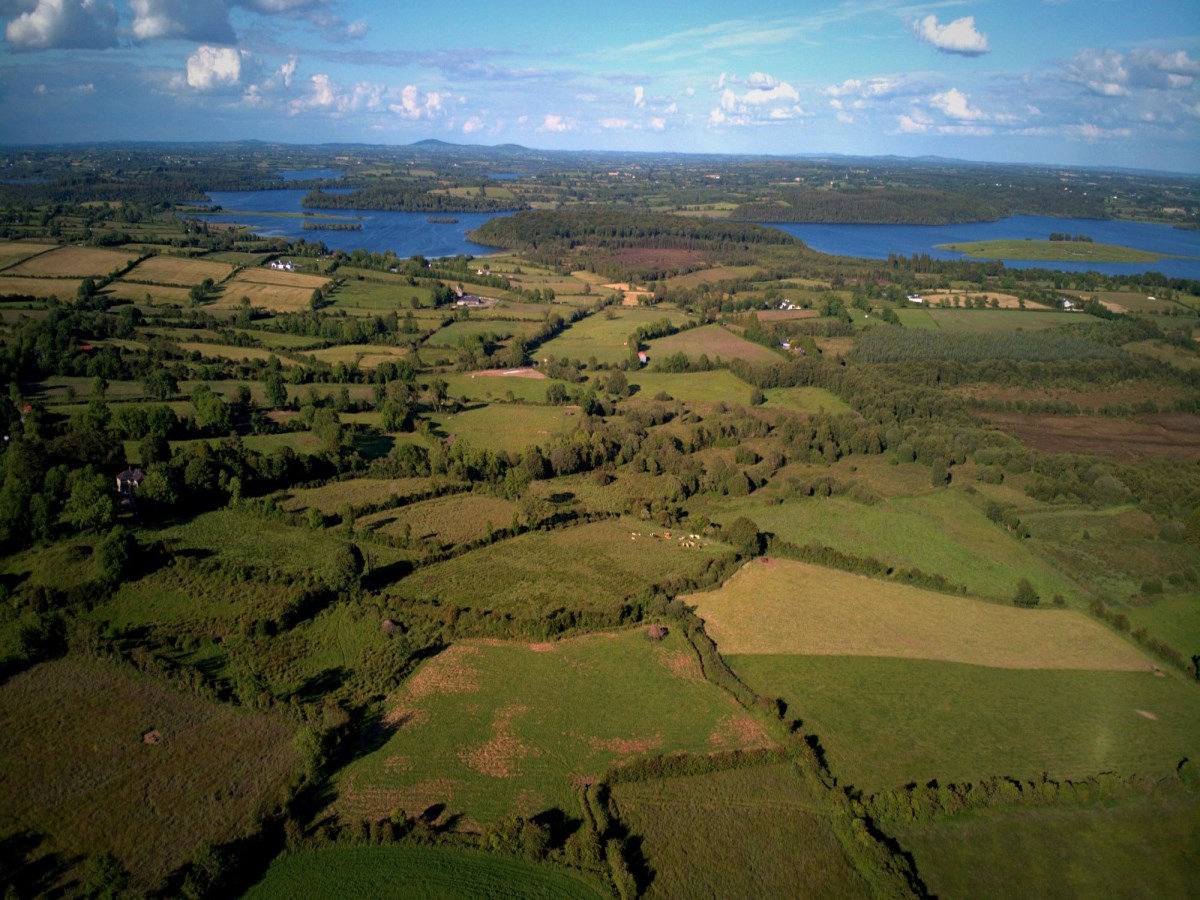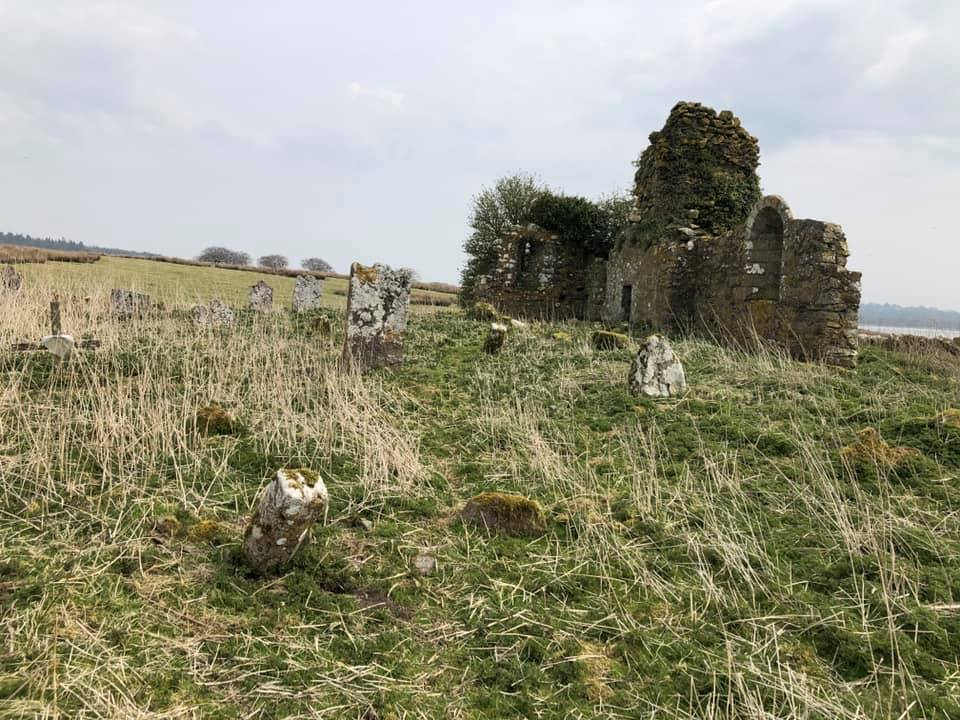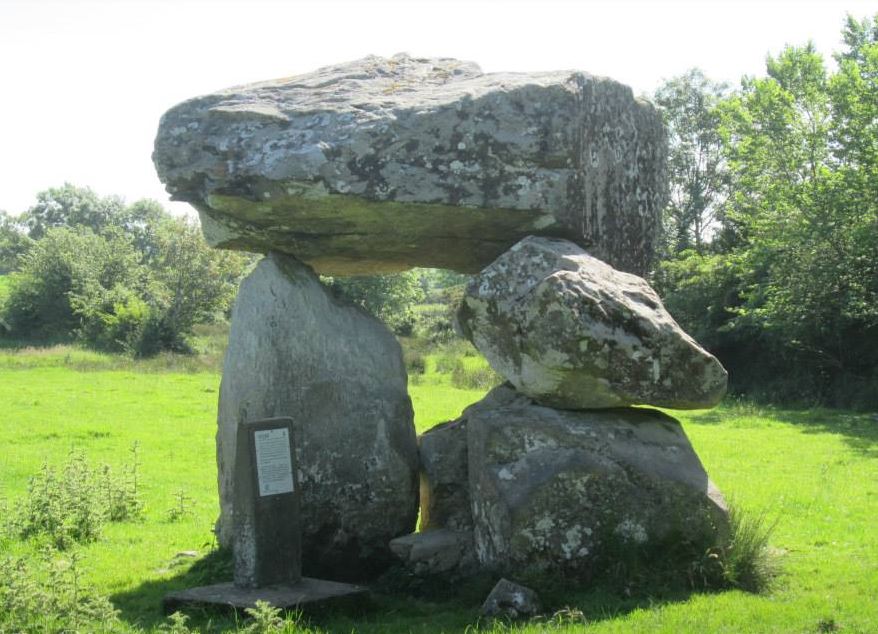Aughnacliffe

Aerial photo of Lough Gowna in Aughnacliffe - image courtesy of Media Eagle
Aughnacliffe is a little village in North County Longford - midway between Cavan town (25 kilometres north to N3) and Longford Town (25 kilometres miles south to N4). North county Longford can be described as a fishermans paradise. The lakes of the Upper Erne system and Gowna are only a few minutes drive away, while in the other direction are the many lakes, which straddle the Longford Leitrim border. Even if the fishing does not interest you, there is the beautiful scenery for relaxing walks, cycling trips, horseriding. Or maybe you just want to visit the many old graveyards, churches, ruins and other historical places, such as the ancient dolmens.
History
The earliest people to arrive in Ireland seem to have been initially reluctant to stray inland. Neolithic man is believed not to have arrived in Longford until the fourth millennium BC. The remarkable Dolmens at Aughnacliffe and Cleenrath, 8 km North of Ballinalee on the western shores of Lough Gowna, are the most conspicuous monument surviving in Longford from this area. The larger Dolmen at Aughnacliffe, consisting of a huge block of stone (3m by 2m) resting on a monolith (2m high), and two smaller blocks of 1m each superimposed on the other, is regarded as one of the finest specimens of this sort of monument in the country. Proof that prehistoric man came to Longford some 5,500 years ago is in the megalithic tombs at Aughnacliffe and Cleenrath and what remains of a tomb at Corrickadorish. The Celts were to follow setting up a stronghold at Dunbeggan on the moraine that overlooks one of the megalithic sites. It is very likely that it was the Millesian Celts who built the eight round forts that surround the church (itself built on a fort). This is because the O’Farrells were the chiefs of the area at the time of the Norman conquests, and they claim to trace their ancestry back to Milosius and his wife Scota, their sons Heremon, Heber, Ir, Finn, and Amergin.
About 560 AD the monks established the monastery of Inis Mór and also the Christian faith in the lake district and remained there until the year 1543. During penal times, the people sheltered the priests who continued to say Mass in secret locations. Catholic Emancipation saw a great improvement with the building of the five national schools in the 1880s. Before that the centre of learning was at the village of Dunbeggan beside the fort. In the year 1867 an Iron Mine was established in Cleenrath and its ore was shipped to Scotland.
The year 1930 saw the start of the creamery in Aughnacliffe, which closed down in 1939. Landlordism came to an end in the 1930s with the razing to the ground of the Dopping Hempenstal mansion, providing the material to build Mullinalaghta church. At the turn of the century, many small farmers depended on the three mills in the area for supplies of oaten meal and flour, namely Kiernans, Bleakleys and Rosduff. Today many of the old Celtic values live on in the people who are very courteous and friendly with a great love of learning, music and dance. This area is renowned for its scenic beauty an excellent fishing. Fishermen come from near and far to fish the many lakes that surround Aughnacliffe.
Things to Do & See in Colmcille
Inch Mor Monastery

The ruins of Inch Mór on Lough Gowna stand as a silent reminder of one of the oldest centres of Christian worship in the North Longford region. Tradition tells us that St Colmcille was born at Gartan, Co Donegal on Thursday 7 December 521 AD. In the year 544 he was ordained a priest at St Finian’s Monastery in Clonard, Co Meath, in all he founded 100 monasteries in Ireland and Scotland. After the Battle of Culgrevny in the year 563, where thousands of the High King’s men were slain in an ambush, St Colmcille was forced into exile at the age of 42 never to return. The next Abbot was St Boodan, who died in 596. The Abbot in the year 800 was M’Laisre, also known as “The Excellent”, because of his sanctity. In the year 804 the monastery was burned and looted by the Danes. For 50 years it was deserted, but in the year 860, when Toicluch was the Lord Abbot he restored the buildings. The monastery served the people as a place of worship and a sanctuary for the sick and destitute for several centuries. The monks lived a very hard life of work, prayer and fasting and Inch Mór was the original of the modern parishes of Colmcille, Purth and Mullinalaghta. In the twelfth century the Abbot adopted Augustinian rules and so continued until the dissolution by Henry VIII in 1543. In that year Bishop O’Farrell sought refuge there, having been expelled from Abbeylara. Later in the year the monks of Inch were also forced to flee the monastery that had been their island home and place of worship for close on 1000 years. It is now the tradition to celebrate the Saint’s death with Mass on the island in remembrance of the death of St Colmcille, when he died peacefully in his bed in Iona Abbey on Whit Sunday at noon, 9th June in the year 597 AD, surrounded by his faithful monks. In 1950 the land on the island was divided and the graveyard was enclosed by stone from the old monastery. As a result of the division of the land on the Island, the ruins of the old Abbey were greatly reduced. In 1986/87 the re-erection of one of the original cut stone windows took place, thanks to money from the European Community. It had been blown over in a storm and was buried in the ground. It stands on the east side of the old monastery facing the rising sun.
The Tower Bell of Inchmore
This is a cast bronze bell of early form, probably made in Italy or France in the 15th century. An inscription in Latin near the base has been partially deciphered: the word magister refers either to God or to a ‘master’ bell-founder. The bell is said to have belonged to the monastery of Inchmore in Lough Gowna, an ancient site associated with St Colum Cille and later an Augustinian house. Early tower bells are a rarity in Ireland and this is among the oldest known. It is believed the bell was used to call the monks to prayer. Having been hidden for many years, it was recovered from the lake and hung in Dunbeggan (Aughnacliffe) about 1840. It remained the only bell there until the great renovation of 1932 when the present bell was installed.
The Aughnacliffe and Cleenrath Dolmens

The dolmen in Aughnacliffe gives the townland its name “The Field of the Stones”. It stands in the lee of a frontal moraine from the last glaciation. This location is unique in Ireland in that three religions were practised here down through the centuries. The first of these religions was practiced by the dolmen builders who originated in the East, possibly the Nile region of Africa or from Mesopotamia. Their religion was known as magic after their priests the Magi. Their priests were skilful in the arts of healing, astronomy and the ritual rights of the dead including the skills needed in dolmen construction. They were made subservient by the Celts who constructed a fortress (Dunbeggan) on the moraine and imposed the second, Druidic, religion. Later Christianity came to the area and a village and church were erected close to the fort. These were finally abandoned in favour of the present village of Aughnacliffe and St Colmcille’s Church in the 1830s. About half a mile due north stands the second spectacular Cleenrath Dolmen, which is also in the lee of a glacier moraine.
Sonnagh Fort
There are seven forts circling the church – all within a radius of 2 kilometres. One of the best situated is the Sonnagh Fort, as it stands in a commanding place overlooking the eastern plains as it extends to Westmeath. Like all the others is would have had a log stockade on top of its earthen walls. Within the enclosure were the house and other buildings. While house types varied most were made of wood and were usually of post and wattle construction. The walls of the houses consisted of a double row of wattle spaced about 20cm apart with a cavity filled with straw and bracken for insulation. The roof was thatched with straw. Wooden posts held up the roof. These forts were the scattered farmsteads of the Millesian Celts who were said to be one of six Celtic peoples to invade Ireland and finally take full control of it. They had a very strict priestly order known as the Druids.



